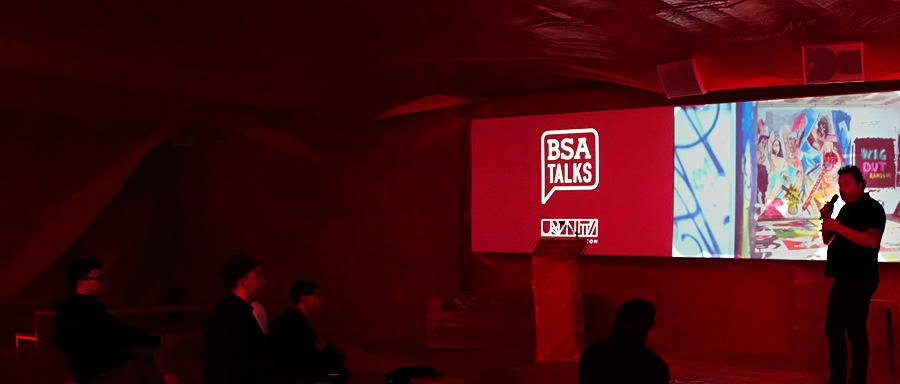We had a question going into the BSA Talks program at Urvanity in Madrid earlier this month: How deep is the street? Turns out it’s very deep.
We had 10 minds from different countries and disciplines on the stage talking to us about a wide range of issues in depth, and armed with a vast wealth of knowledge.
As we reflect on our week in Madrid we realize that we came out of it vastly enriched. The knowledge shared on the stage came from people who have devoted a great part of their lives researching, studying, producing, traveling, writing, exposing, taking risks, creating on the streets, on stages, outdoors, indoors, alone, with a team, with funds, without funds.

Many have made their own path by walking.
Multiplying the effect was the fact that we were presenting in a bubble. Perhaps that is a metaphor to some, but in this case our three day exploration was while inside a room that had been covered with plastic top to bottom, side to side; a red bubble cave made of plastic. The site specific installation by the Madrid based collective Penique Productions changed our very perceptions because everything was drenched in a red/pink glow.
Here are some of the images from those few mind-expanding days;

From the start, big thinker Denis Leo from Berlin spoke to us with his current vision on “The Intelligence of Many” and what it means in terms of collaborative place-making, curating, and problem-solving. It seemed a perfect note to begin as we contemplate a world where long established hierarchies are flattening and power is reallocated to those who can work collectively and independently. He reminded us that pretending to know about art may mean that we close our mind to new opportunity, new experiments and possibly the whole point.
Following

Juan Peiro from Spain and Sergio Pardo from New York spoke about how we can thoughtfully program works that respond to the rhythm of a city, cognizant of its systems, in concert with its various populations.
A New York City Arts programmer and a professor at Universitat Politècnica de València, the two of them have worked in public space with artists and the community. Each had valuable observations about the interactions. An underlying theme: What is “creative placemaking” and how does one obtain permissions from all the parties who are affected by works in the public sphere?

Prague based multidisciplinary artist Jan Kaláb spoke about inclusivity and exclusivity in Street Art as seen through the eyes of someone who’s art practice has continuously evolved in the past two decades. Reclining on the plastic red couch with

Alberto González Pulido from Madrid touched on a timely and very important set of topics from the Gag Law in Spain, censorship to copyrights and artists’ intellectual rights. Armed with in-depth detail about current laws that are evolving to address Internet matters and copyright and free speech – casting a frightening pall of power overreach by corporations into areas exclusively reserved for our courts and governments. The main message for us was that we all need to educate ourselves.

Sabina Chagina from Moscow took us on a personal trip and shared her experience and the process and difficulties co-founding a Biennale of Street Art in Moscow, a city with practically no culture of street art on the streets. A frank and open sharing of knowledge, it was instructive on how huge projects can come together with the right partners and the ability to pivot when necessary toward opportunity. Also, think big!

Susan Hansen and Bill Posters took us on a learning trip with their lectures about hacking public space with subvertising, brandalism, collaborative interventions, the street practices of Creative Activism. They both spoke of the role that activism plays in a time of social-political-psychological upheaval and how Street Artists are using the existing public furniture to disseminate their message – and reclaim public space.


And finally curator, visionary, publisher and gallery owner Pascal Feucher from Berlin spoke about the importance of nurturing artists and giving them the space and the freedom to create, experiment, fail, learn and succeed.

Three days of intense learning and meeting people and talking about why we do what we do – and the importance of remaining independent and
Other Articles You May Like from BSA:
If you haven't gone barefoot in the park yet this summer, what are you waiting for? Everybody's doing it. Not recommended for the sidewalk in Bushwick, Bedstuy, ...okay, most of Brooklyn. Limit ...
Welcome to BSA Images of the Week! Clocks spring ahead today in New York! Check it! Taking a little trip to Miami and Wynwood District this week - its a lot warmer than New York. Hey, is a...
As the world looks on and Americans are deciding which of the world's refugee children to ban from the country, London-born Street Artist Sebastien Waknine has created a new work in Barcelona called “...
Jorge Rodríguez-Gerada is working in a Spanish wheat field. Would you like to lend a hand? Jorge Rodriguez-Gerada. "Nourishing Self-Esteem". Estopiñán del Castillo, Spain. (Ana Álvarez-Errecalde) ...
“...multiple emotional states caught between contemplation and confrontation” The Gateway Arts District is a vibrant arts community located in Mount Rainier, Maryland, near the northeastern bo...
 BROOKLYN STREET ART LOVES YOU MORE EVERY DAY
BROOKLYN STREET ART LOVES YOU MORE EVERY DAY










